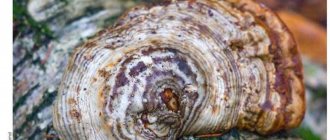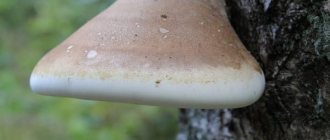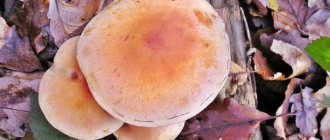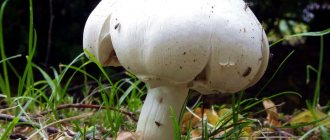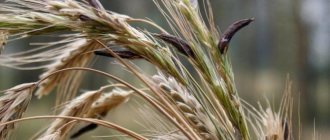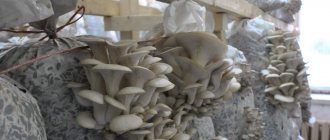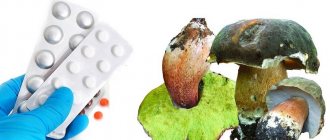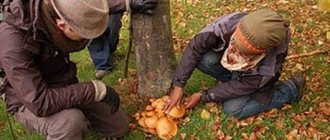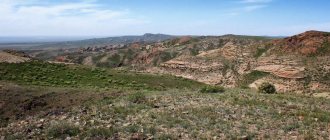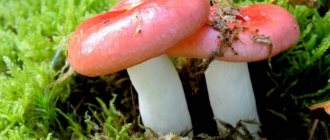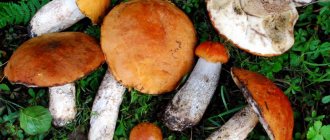Tree mushrooms: varieties, features
Fungi are called arboreal because of their main feature - they penetrate the bark of a dead or living tree and decompose it using special enzymes.
By destroying cellulose and other polysaccharides, they use them for their own development and growth. They belong to the group of xylotrophs. There are edible and inedible types of these mushrooms, studied by the science of mycology. Edible parts are useful for humans, contain proteins, vitamins B and C, iron, phosphorus and calcium. “Muer” is the name of a tree mushroom translated from Chinese, which has long been often used in Pan-Asian cuisine.
Features of wood mushrooms
Many types of tree mushrooms act as forest health workers, since they are bred on weakened trees and help the natural selection of quality species. Representatives of such “orderlies” known to us, for example, are honey mushrooms, which grow beautifully on stumps in a large family and attract mushroom hunters with a spicy aroma. In addition, they are tasty, crispy, and are especially loved by gourmets when marinated.
But there are mushrooms that are completely different from traditional ones; they have neither a cap nor a stem. They are qualified and recognized by their shape and appearance, which reminds us of things familiar in everyday life. It never occurred to anyone to collect them and taste them, so the taste qualities of these eccentric specimens are not known for certain.
Such xylotrophs can be distinguished by a description of their appearance:
- Meat pieces (Askokorine meat);
- Resin in the form of a drop (Exidia ferruginosa);
- Bubble foam (Dacrimitses vanidas);
- Corals, sponge (Kalocera).
Even among mushrooms there are parasites that eat their relatives. For example, the sulfur-yellow hypocrea, which feeds on colonies of exidia or tremors.
Particularly dangerous parasites for forests include northern Climacodon, a representative of the subspecies Polypores. It penetrates into the body of a healthy tree through cracks and cuts and completely destroys it within 4 years.
Gardeners and park workers should be wary of such parasites, because they can completely destroy the garden.
Cooking recipes
Podoreshniks are mainly prepared in the form of pickles; other methods are used less frequently and are not so popular. In addition, preparing oak milk mushrooms takes a lot of time and not everyone is ready to spend several days on this process.
Primary processing
A prerequisite is soaking the milk mushrooms. They have very caustic juice, and therefore they should be kept in clean water for several days, periodically draining it and replacing it with new water. Some mushroom pickers advise adding salt (2 tbsp per 1 liter). The stuck dirt is removed from the caps, and then the fruiting bodies can be boiled.
Cooking
Place the prepared milk mushrooms in a saucepan, add water so that it covers the surface of the mushrooms, and place on medium heat.
Important! As the fruits cook, they release juice, and therefore you should provide free space in the pan, because
the volume of liquid will increase.
Cooking milk mushrooms takes 15–20 minutes. They can then be salted, pickled or fried.
Pickling
To prepare the marinade for 1 kg of milk mushrooms in water (2 l), you need to put:
- 2 tbsp. l. salt;
- 1 tbsp. l. Sahara;
- 3 pcs. laurel;
- 5 pieces. currant leaves;
- 2 cloves of garlic;
- 3 pcs. peppercorns.
Sequencing:
- Put everything on the fire, bring to a boil.
- Add mushrooms and cook for another 15 minutes.
- Then the fruits are placed in prepared jars, 2 tsp are poured into each of them. vinegar, fill the remaining space with brine.
- Put it in a cool place, after a month you can eat it.
Freezing
You can store boiled milk mushrooms in the freezer, which are pre-cooled and placed in bags. With such freezing, salt should be added to the water during cooking to taste.
In addition, after boiling, the mushrooms can be fried for 20 minutes, adding spices. The entire mass must be cooled, divided into portioned containers or bags and placed in the freezer.
Frying
The prepared mushrooms are boiled, then you can start frying. To do this, for 1 kg of mushrooms you will need:
- 1 large onion;
- 1 medium sized carrot;
- 2 tbsp. l. vegetable oil;
- salt and pepper to taste.
The frying process lasts at least 20 minutes. Sequencing:
- Finely chop the onion and place it in a frying pan with a small amount of vegetable oil.
- Add grated carrots and fry until the onion is transparent.
- Then add the mushrooms and cook everything together for 15 minutes.
You can add any favorite spices or sour cream, then just simmer the mushrooms for 3-5 minutes. The resulting dish is served separately or with a side dish; it will be a wonderful addition to the holiday table.
Salting method
The fruit bodies are boiled, cleaned, and enamel dishes are prepared. Most often for pickling 1 kg of mushrooms they use:
- 200 g salt;
- 4 laurel leaves;
- 3 cloves;
- 2 leaves each of horseradish and currants;
- allspice – 5 peas.
To pickle pine nuts, you need to do the following:
- Place the fruiting bodies in layers in the prepared container.
- Sprinkle with salt and your favorite spices.
- Place gauze on top and press down with a plate, set the weight.
They should be salted in a cool place, after a week the mushrooms will be ready, they can be put into jars.
Drying
None of the varieties of milk mushrooms are dried. Oak is no exception. This is all because of the caustic milky juice, which during the drying process transfers bitterness to the mushroom, and it becomes completely unsuitable for food.
Canning for the winter
To properly preserve milk mushrooms for a long winter, after soaking they should be boiled with the addition of citric acid: for 3 kg of fruit, 0.5 tsp is enough, cook for 15 minutes. Then, having caught the mushrooms with a slotted spoon, you need to put them on a hot frying pan and fry for 20 minutes until the excess moisture has evaporated.
For further preparation you will need:
- lard – 0.5 kg;
- onions – 1.5 kg;
- garlic – 10 cloves;
- salt and pepper - to taste.
Further preparation:
- Put lard. Cook the milk mushrooms over low heat, stirring occasionally.
- After this, cut the onion into half rings and add to the pan, fry for another 20 minutes.
- Then add salt and pepper, add finely chopped garlic, stir, and after a couple of minutes, pour the mixture into jars.
- The rest of the space needs to be filled with melted lard and mushroom broth.
- The containers are placed in hot water and sterilized for 40 minutes. over low heat. Then they are rolled up with sterile lids, cooled at room temperature and stored in a basement or other dark, cool place.
Types of tree mushrooms
Mushroom hunters pay attention to apparently unusual species found in the forest on the trunks of rotten or diseased trees and dead wood. In mid-summer and autumn, you can find adult specimens of the most interesting mushrooms, a description of which is presented below.
Askokorine meat
It got its name because the fruiting body resembles pieces of meat of pink-violet shades with plates no more than a centimeter, united over one saucer. Most often found on birch stumps. Does not have a pronounced aroma. The unsightly appearance scares off mushroom gourmets, so its taste is unknown.
Bjerkandera
Belongs to the tinder family and is distinguished by tape-like growth within one year. A mature mushroom of dark brown color resembles a braid of caps, no larger than 3 cm in size. The pulp is fragile, gray in color, and odorless. A thin spore-bearing layer with a clear boundary separates the body of the mushroom from the brown oily cap, as if always wet and grayish at the ends.
Spreads on dead wood and dead wood. It tastes like regular tinder fungus.
Oyster mushroom
Oyster mushrooms quickly burst into our lives, greatly facilitating the preparation of many dishes with rare species of tree mushrooms. Growing quickly in an artificial environment, having a wonderful aroma and good taste, they have become undoubted sales leaders. Specimens bred on mushroom farms are not comparable in taste to wild varieties. They grow in large families on the trunks of living and dead deciduous fruit trees.
You need to look for them in spring and autumn in Crimea.
The fruiting body consists of a long elastic stem and a matte cap. Oyster mushrooms come in a variety of colors, from pale gray to orange, and all of them are edible and tasty.
Hypocrea
Hypoclea sulfur-yellow is an inedible parasitic mushroom that feeds on relatives of the Trembling family (most often they include Exidia glandularis). Accordingly, the seasons and places of growth of this species coincide with its “victims”.
Appearing on the body of the trembler, the hypocreas grows several yellow spots, which then merge into one surface. It forms a large golden spot on the body of the tree fungus with black dots - spore-forming fruiting bodies. It looks like a dense, uneven sponge ranging in size from 1 to 15 cm.
Ram mushroom
This fast-growing mushroom from the polypore family is also called Grifola curly. In our country it is rarely found, only in deciduous forests on old logs and stumps. Such mushrooms weighing 9-10 kg have been found in nature.
Many thin legs of the ram mushroom turn into brown caps with gray and greenish hues along the wavy edges. The light fruit body has beneficial properties and smells pleasantly of nuts.
For these properties, the mushroom is widely used in cooking and has become the medicinal basis of folk recipes for the treatment of pulmonary diseases.
Dacrimitses
A fairly rare small, up to 0.5 cm, yellow oval mushroom. It loves water, dampness and rotting stumps of coniferous trees, so in dry weather it hides in the bark of dead wood, as if spreading out and becoming flat.
Due to its yellow hue and structure, it looks like foam bubbles scattered in small drops on wood. The body of Dacrimyces has neither taste nor aroma. It is inedible, but not poisonous either.
Kalocera adhesive
In the forest, it usually settles on rotten wood and occupies this place completely, that is, other mushrooms will no longer grow here.
Kalocera strongly resembles coral, bright yellow, sometimes orange. Reaching a length of 6 cm, the horn-like processes grow together at the base and “create” a bouquet. Such formations parasitize on rotten wood and reproduce throughout the summer.
Each mushroom, rubbery to the touch, has 2-3 sharp, branched tops.
This species was classified as neither edible nor poisonous due to its rarity.
Growing floodplains
Podtopolnik can be grown artificially. The main condition for growth is suitable temperature. Fruiting bodies begin to grow only when the temperature drops to 15 °C. There are two options for growing - outdoors and indoors.
Growing outdoors
It is technically easier to grow the mushroom outside. Bookmarking begins in May. The crop is placed in boxes or bags with substrate and laid out on beds. As a substrate you can use:
For 5 kg of soil add:
- chalk – 100 g;
- water – 1 l;
- mycelium (vegetative body of mushrooms) – 50 g.
Further procedure:
- After mixing the mixture, place it in prepared containers.
- Sprinkle wet soil on top. Cover with film. Ideal conditions for mycelium are high humidity, air circulation and a temperature of 20 °C.
- After the soil has become overgrown with mycelium, the film is removed. The substrate is placed in the shade. The first fungi will appear 5-6 weeks after planting.
Mushrooms are afraid of frost. Before their onset, it is necessary to cover the mushroom “vegetable garden” with straw, grass, and leaves.
Every time, after collecting another batch of mushrooms, the soil is watered. Or add moist soil - this is even better.
Growing indoors
To grow a decent poplar crop indoors, you need special conditions:
- high humidity;
- temperature regime in the range of 12-15 °C;
- constant ventilation;
- natural light;
- moistening the substrate;
- Sprinkling the mycelium with damp soil.
Podtopolnik is considered a tasty mushroom that is not difficult to find or grow yourself. It is also popular and in demand in many countries, which makes its cultivation profitable.
Podtopolnik belongs to the conditionally edible mushrooms, as it absorbs harmful substances. It is also known to experienced mushroom pickers as poplar row. From the name it is clear that they grow in whole families, just like honey mushrooms. Therefore, you can immediately collect several buckets from one place.
There are poisonous analogues of the tortoiseshell, so you need to know how to distinguish them. Beginning mushroom pickers need to familiarize themselves with its features:
- The fleshy cap has a hemispherical shape and pink plates. As it grows, it straightens, and the plates darken and acquire a reddish and brown color.
- On a fresh poplar row, the cap should be slippery and wet. Its diameter can reach 12 cm.
- The leg has a cylindrical shape, which thickens at the bottom.
- Edible mushrooms have a floury and cucumber flavor.
Young specimens have the best taste and dense flesh. But old floodplains have a bitter taste.
The benefits and harms of tree mushrooms
The benefits of edible species of tree mushrooms are scientifically proven. They contain absolutely no fat. Their main useful components are:
- vegetable protein;
- vitamins C, B, especially a lot of B3;
- Microelements calcium, phosphorus, iron.
In such types of mushrooms as tinder fungus, shiitake, chaga, it is not culinary, but pharmaceutical properties that predominate. Various substances and mixtures are prepared from them that can treat the symptoms of certain diseases:
- lack of iron in the blood;
- high blood pressure;
- high levels of stomach acidity;
- reduced immunity.
Tree fungi can be considered harmful only because they spread widely and quickly on healthy trees in human-cultivated areas - gardens, parks, artificial forests. Once on the bark of a damaged area of a healthy trunk, fungal spores quickly multiply and destroy it in just a few years.
If wood damaged by animals or frostbitten is treated in time with garden varnish, this danger will disappear.
Mr. Summer Resident recommends: tree mushrooms - beneficial properties, use in cooking
The tree mushroom Chaga birch has become famous for its medicinal properties - teas and decoctions from it have a powerful immunostimulating and tonic effect.
Planting mushrooms on a farm has become a profitable business and now we often see tasty and nutritious oyster mushrooms on sale, which are also classified as woody mushrooms. In nature, they come in yellow, greenish and other shades and grow in a large family. Forest species are much more fragrant than their artificially bred relatives. A big plus is that they do not have poisonous counterparts.
Tree ears, as the mushrooms are called because of their resemblance to the shell of an ear, are very popular in oriental dishes. However, they are rarely prepared as an independent dish, since they do not have a special aroma or pronounced taste. Mushrooms are good as a side dish in combination with meat, giving it a subtle smoky flavor. The crispy and dense consistency is pleasant to the taste and nutritious, especially well seasoned.
Undoubtedly, tree mushrooms have taken their rightful place in human nutrition: it is not for nothing that we are increasingly seeing them on supermarket shelves, thereby enriching the diet with healthy and nutritious protein products.
Preparation
Pickling
The most interesting thing besides picking mushrooms in the forest is cooking. The pickling recipe is simple. All you need is a large amount of salt. Horseradish, cherries and dill are also added to the preparation.
Mushrooms are generously rubbed with salt and placed either in jars or wooden barrels.
Important! There are no tight lids on the jars; all microbes develop precisely under such conditions, which leads to poisoning. Also, the taste will be transformed by adding sugar to the marinade at the very end of salting.
Also, the taste will be transformed by adding sugar to the marinade at the very end of salting.
Salting time is approximately 40 days. During this time, the mushrooms will have time to marinate properly. But it is undesirable to overcook such jars, postponing their consumption until later. If they are stored for more than six months, you can get poisoned by eating them.
These mushrooms are not very suitable for preparing stewed or fried dishes; they are also rarely used to make soups, since aspen milk mushrooms require a long time of processing.
Milk mushrooms cannot turn out tasteless, as they are easy to prepare.
Note: to check whether the mushrooms are marinated enough, you need to try it. Chew the mushroom and feel; if it is not bitter, then rinse and cut large mushrooms.
Pickled milk mushrooms are usually served in oil or used in salads.
Raw milk mushrooms
Sort the mushrooms, peel and wash them. Soak in a salty solution, which will remove the bitterness. Mushrooms are poured with boiling water into containers and sent to the freezer.
Boiled milk mushrooms
Also peel and cook. After boiling, it should take about 10-15 minutes, then drain the water using a colander. The drier the mushrooms, the better they will taste when cooked. Also place in containers and place in the freezer.
Fried or stewed milk mushrooms
Chop the mushrooms, add oil and fry in a frying pan for 15-20 minutes with the lid closed. During the last few minutes, remove the lid to form a crust on the mushrooms. Place the finished mushrooms in containers and place in the refrigerator.
The dietary method is cooking in the oven without oil. Place the mushrooms on a baking sheet and set the oven temperature to 175-180 degrees. Don't forget to stir periodically.
Edible mushrooms growing on poplar trees
Of all the mushrooms that grow directly on poplars, the safest is oyster mushroom, since it has no poisonous counterparts. But with the rest you need to be careful.
Autumn oyster mushroom
It can be found in the forest from September to October. It grows directly on a poplar trunk, stump or dead part of a tree in a group, often fused with short legs, in the shape of a curved cylinder. In some cases the leg is missing. The length is about 3 centimeters and the width is up to 4. Also, the leg has a dense structure, covered with small scales, most often colored in yellow, brown and greenish shades.
Aspen milk mushroom: how to cold salt
It is this method of salting milk mushrooms that has always been used in Rus'. It has survived to this day. For pickling, oak barrels were used, the same ones used for preparing sauerkraut and pickled tomatoes and cucumbers. At home, you can use deep dishes made of glass or clay.
To prepare aspen milk mushrooms in a cold way, you need the following ingredients:
- peeled milk mushrooms (caps) – 1 kg;
- salt – 2 tablespoons;
- garlic – 2 cloves;
- leaves of cherry, currant, horseradish.
First you need to prepare the mushrooms. Since they usually grow under last year's foliage, it is quite difficult to clean off the buildup on the cap. To do this, aspen milk mushrooms are dipped into water and cleaned with a knife and sponge. Some mushroom pickers use a different method. The milk mushrooms are soaked in cold water for 2-3 days with its systematic replacement, and only after that the caps can be easily washed with a soft sponge.
The stem of the peeled mushrooms is removed, and the caps are lowered into the bowl with the plates facing up and filled with water for a day. During this time, it must be replaced at least three times. After the specified time, the mushrooms should be removed from the water. Then, at the bottom of the dish prepared for pickling, green leaves and spices are laid out, a layer of milk mushrooms, again greens and again mushrooms. Next, you need to cover with a plate and put under a press until the juice appears. They will stand in this brine in a dark, cool place for 40 days, and only after that the milk mushrooms can be transferred to jars.
What mushrooms can be found under poplars?
The most common mushrooms found in poplars in the fall are mushrooms, milk mushrooms, and boletus mushrooms.
Poplar row
The conditionally edible poplar row has the shape of a hemisphere with thin curved edges when young. Over time, the mushroom cap straightens and becomes more voluminous. The cap of the poplar row grows up to 12 centimeters in diameter.
Under the cap there are often thin plates located. The color of the plates can be white or pinkish-brown. The leg is fleshy with a scaly coating and has the shape of a cylinder. The color of the leg is pinkish-white or light brown. When the legs are squeezed, brown spots appear.
This species grows in deciduous forests, under poplars, in dense clusters. The growth period for poplar row is from August to the end of October. The row is often used for preparing various dishes. Before cooking, the mushrooms are thoroughly washed, soaked in water, and then boiled. This treatment eliminates excess bitterness.
Gray boletus
The gray boletus has a cap in the shape of a hemisphere, with curved edges, up to 15 centimeters in size. The hat has an uneven and textured surface to the touch. The color of the cap is gray or brown-gray.
The flesh of the mushroom is white, when cut, it acquires a pink tint, and after a certain period of time it turns black. Gray boletus has a pleasant aroma and taste.
The boletus leg reaches 14 centimeters and has a thickness of 4 centimeters. The upper part of the leg is gray, the lower part is brown. Also, the leg is covered with white or yellowish-brown scales. Ripens from June to the end of October. It usually grows under birch trees, but can often be found near poplar trees. Gray boletus is suitable for preparing various dishes.
Milk mushrooms aspen and blue
Aspen (poplar) milkweed grows in a dense cluster. A special feature is the presence of a large amount of white juice in it, which protects the mushroom from parasites.
The breast has a funnel-shaped cap measuring about 14 centimeters. The hat has a pink tint, is covered with fluff and is sticky to the touch. The plates are frequent, narrow and extend from the cap to the stalk. They have a white or pink tint. The leg is small, but very dense. Breast milk is more suitable for pickling because of its bitterness. It must be soaked for a long time beforehand. It is not suitable for drying.
Description of the floodplain
Podtopolnik belongs to the group of lamellar mushrooms. Reproduces by spores. The main difference is the special smell. If you smell poplar trees, it seems like you are smelling fresh flour - this smell makes them unusually tasty when pickled and salted.
Mushroom pickers value young mushrooms. They, unlike the “old ones,” have an unopened cap, and most importantly, there are practically no worms in them. But due to the fact that the “young growth” hides in the ground, it takes a long time to clean and wash it before processing. How to find out the row:
- Hat shape. In young mushrooms it is hemispherical. As they grow older, the cap opens up. At first it is convex, and then depressed, covered with cracks. The “long-lived” hats reach a diameter of 18 cm. The old hat has uneven, cracked edges. It is fleshy, and if it rains, it is slippery.
- Color. The plates are thin and dense, white or cream in color. Over time, their color changes - the plates become pinkish-brown. Reddish spots may appear on old records. The color of the cap ranges from yellow-brown to gray and red-brown. If you remove the skin from the cap, the flesh underneath will be slightly reddish in color.
- Pulp. Fleshy and white. The taste is mealy-sweet.
- Leg . The length is usually 3-6 cm. But it can reach 12 cm. The diameter is 1-4 cm. The shape is cylindrical. On the smooth and fibrous stem there is a flaky-scaly coating.
Inedible species
Such mushroom neighbors of poplars include scale, false valu and inedible honey fungus.
Destroying scale
It is also called poplar flake. This species, in the process of its life activity, destroys the tree on which it grows. The cap of the destructive scale reaches 20 centimeters in diameter and has a white or light yellow tint, all of it is covered with large white scales. In adult mushrooms, scales are absent, and the edge of the cap becomes uneven and fibrous. The plates of the cap are white and fused with the stem, becoming dark brown over time.
The stem of the mushroom reaches a length of 5 to 14 centimeters and 3 centimeters in diameter. The color of the stem is the same as that of the cap. It is also covered with white scales, which disappear over time. A white ring forms on the stem. Such flakes are inedible and have an unpleasant taste and smell.
False brick-red honey fungus
False honey mushrooms have a bright brick-red color and are poisonous. They are most similar to autumn honey mushrooms. In appearance, they are practically no different from edible honey mushrooms.
You should pay attention not only to the brick-red hue, but also to the fragments of the white covering layer, which remains on the edge of the cap in the form of large flakes and resembles a fringe. An important difference is the absence of a specific ring on the stem. This honey fungus selects fallen trees for growth in well-ventilated deciduous forests. If eaten, this mushroom can lead to the death of a person if medical assistance is not provided in a timely manner.
False Valuy
False valui is a dangerous poisonous species, often found in forests and fields, growing in large clusters in the autumn season.
Externally, the false valu is similar to the edible valu. But when you cut the first one, you immediately feel the characteristic pungent smell of horseradish, which quickly disappears. Another characteristic difference is that the false tree is not affected by worms. If a false representative is consumed, signs of poisoning may appear after 10 minutes, and the person requires immediate medical attention.
Where do floodplains grow and when can they be collected?
You can find mushrooms in Eastern and Western Europe, Canada and Central Asia. In Russia they are common in Siberia. In most cases, they grow in rows and heaps.
From the name it is clear that the mushroom grows in close proximity to poplars. Therefore, they must be collected in deciduous forests. Podtopolniks usually hide in the ground and under leaves.
Fruiting begins in mid-August. If the weather is favorable in the fall, then the row can be collected until mid-October.
Due to their ability to absorb harmful substances, it is not recommended to collect mushrooms in industrial areas and near the road. Experienced mushroom pickers know that when you find one poplar row, you need to look around, since there should be a whole family of poplar mushrooms nearby. When a group of mushrooms is found, you need to carefully remove the leaves and soil from them, and then cut off the stem with a knife.
Inexperienced mushroom pickers may confuse the mushroom plant with the voluptuous mushroom, which can cause an eating disorder. Therefore, there is no need to collect mushrooms under coniferous trees. Another difference is that wavy-legged specimens do not grow in groups. In the image below you can see what a poisonous mushroom looks like.
Another difference between Potopolnik and other mushrooms is the pronounced floury or cucumber smell. In addition, they hide, so you can only notice a round brown cap that resembles a potato.
There is nothing wrong if you pick this mushroom, as it is also edible. If you are going to the forest for mushroom hunting for the first time, it is better to ask an experienced person to accompany you.
